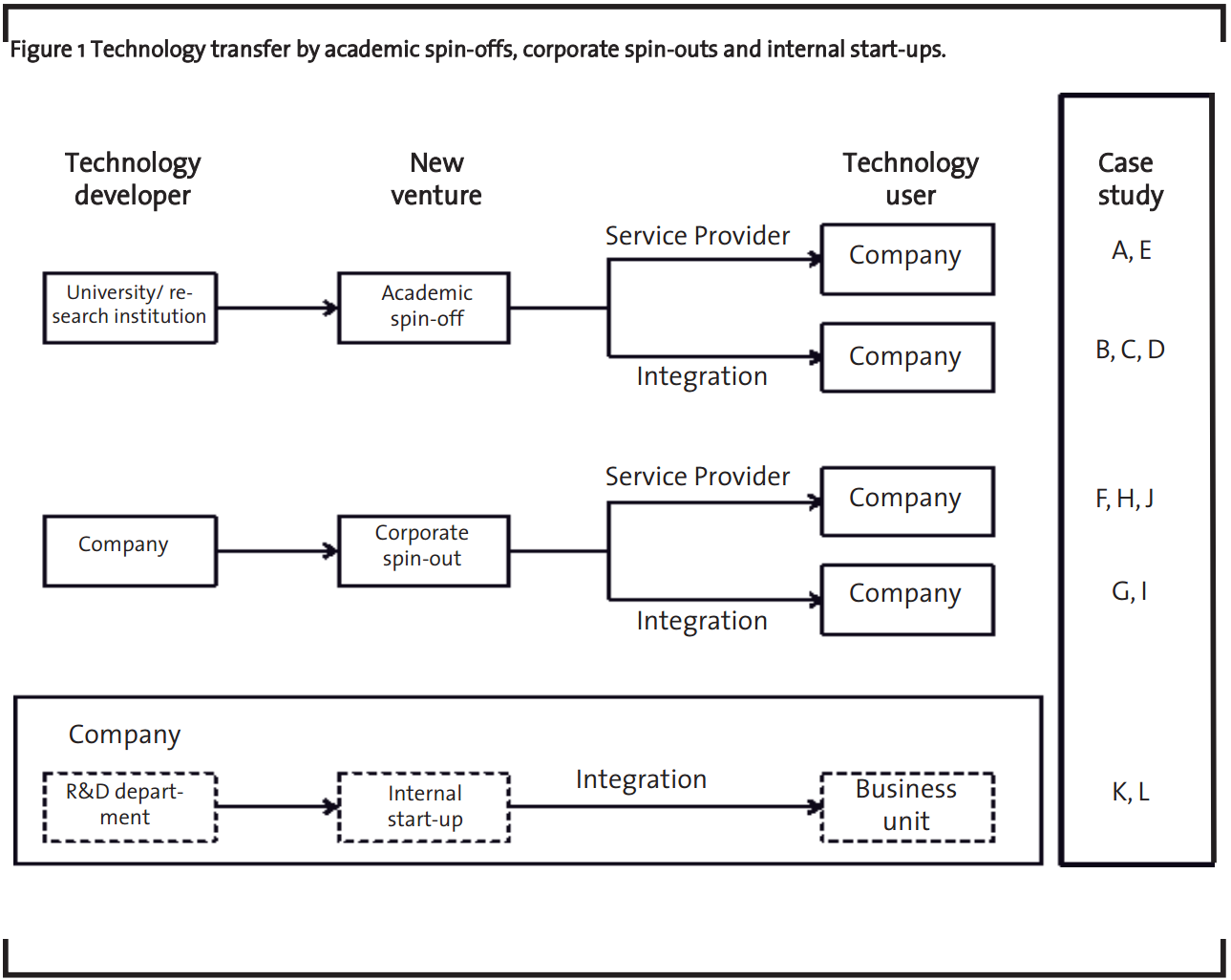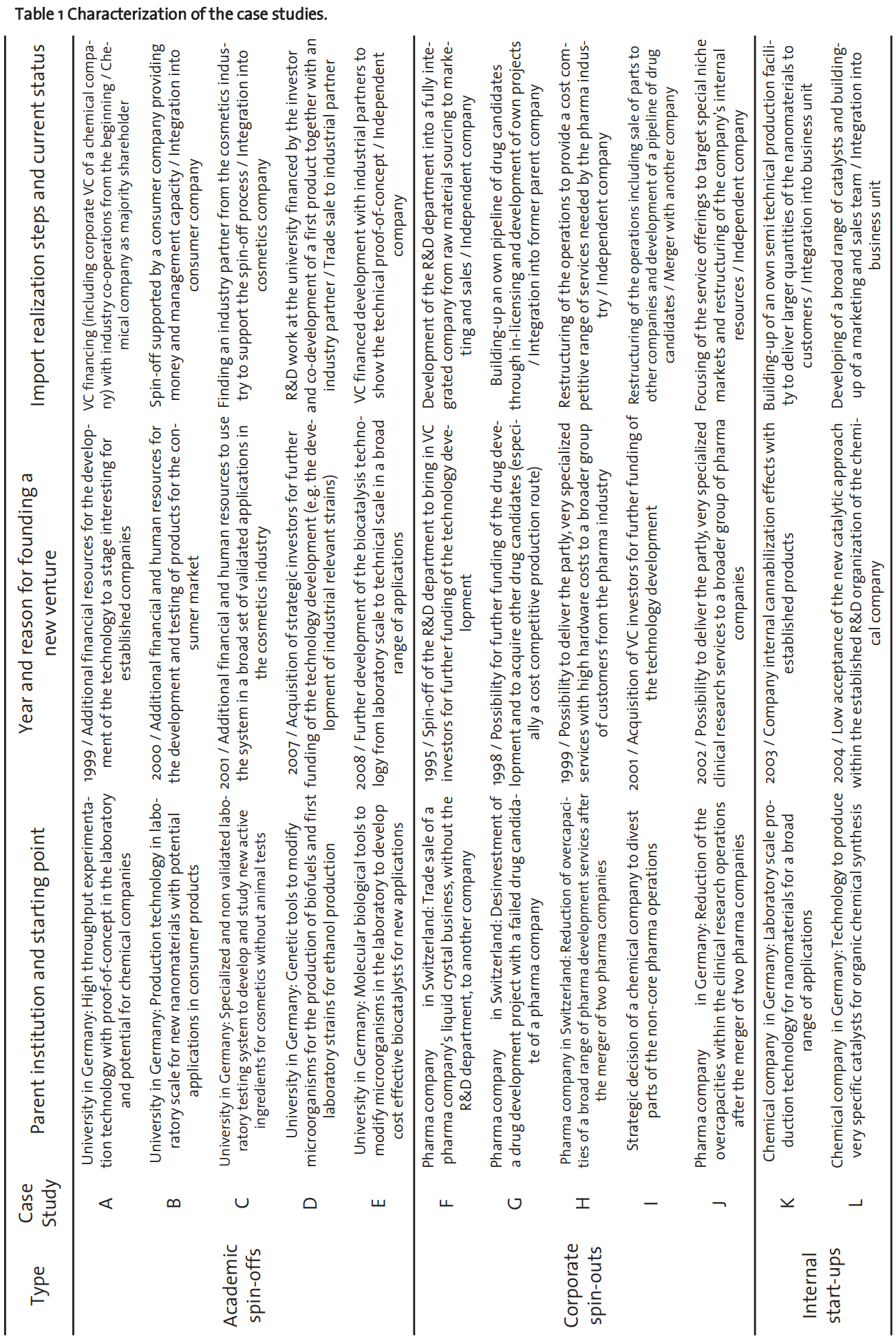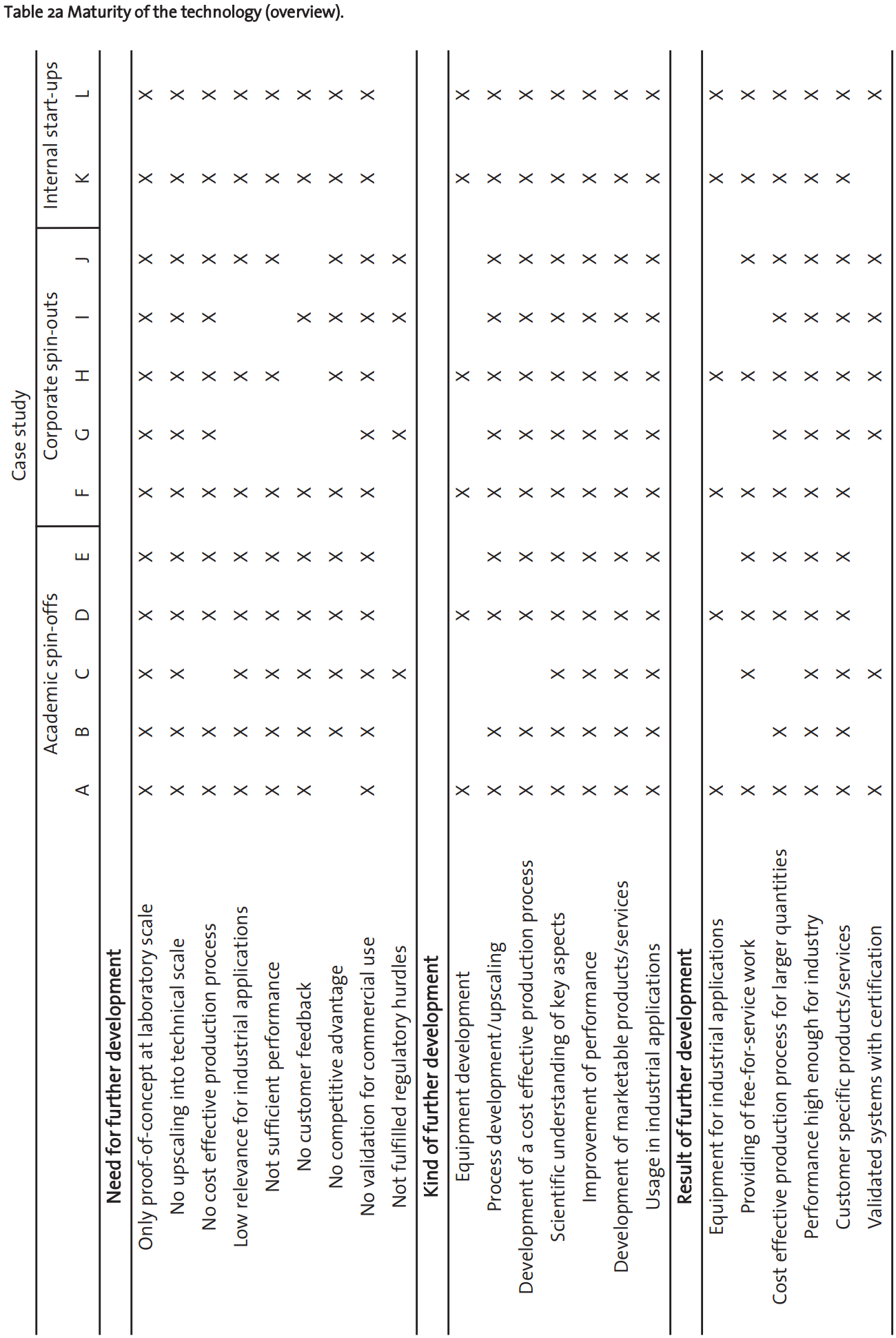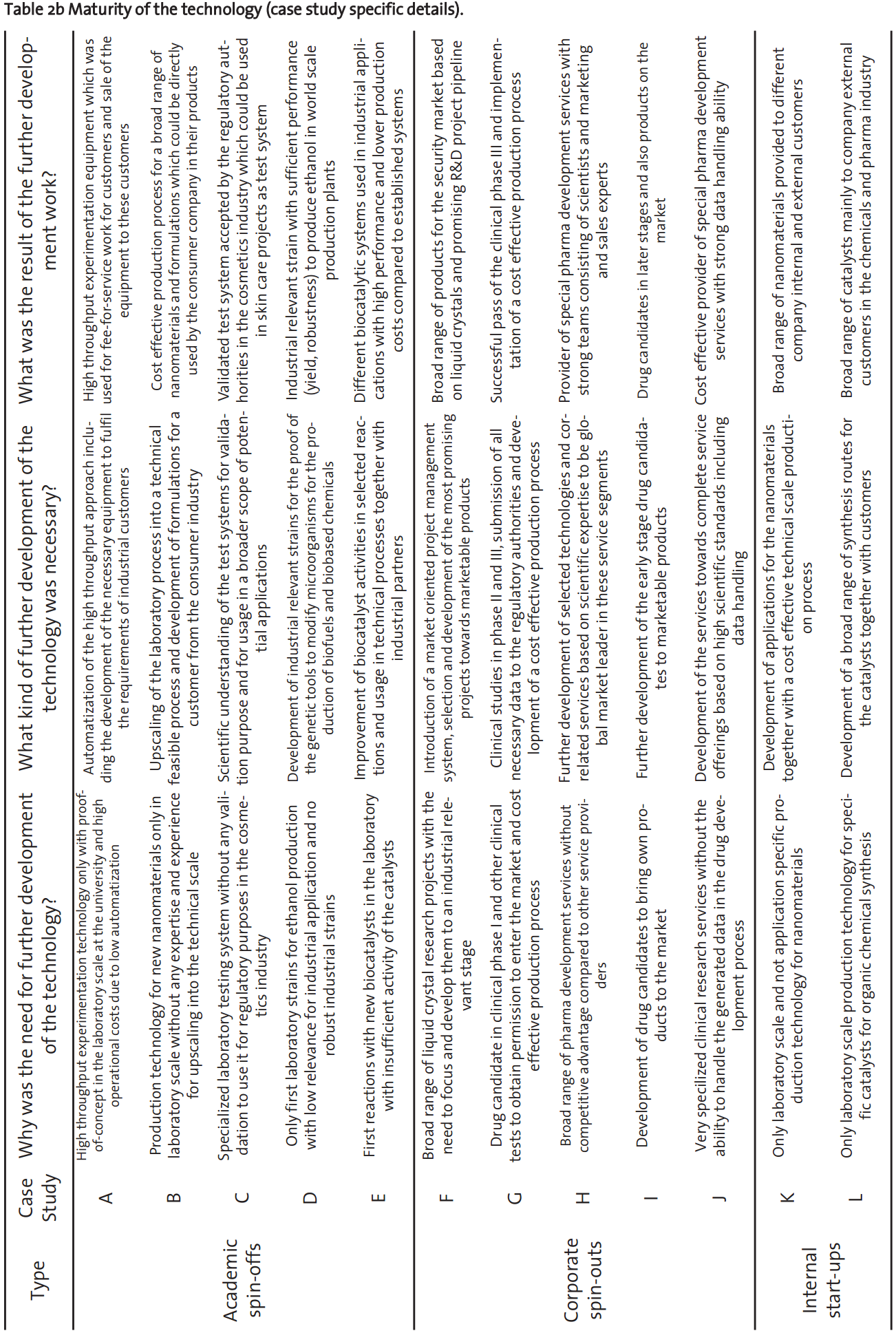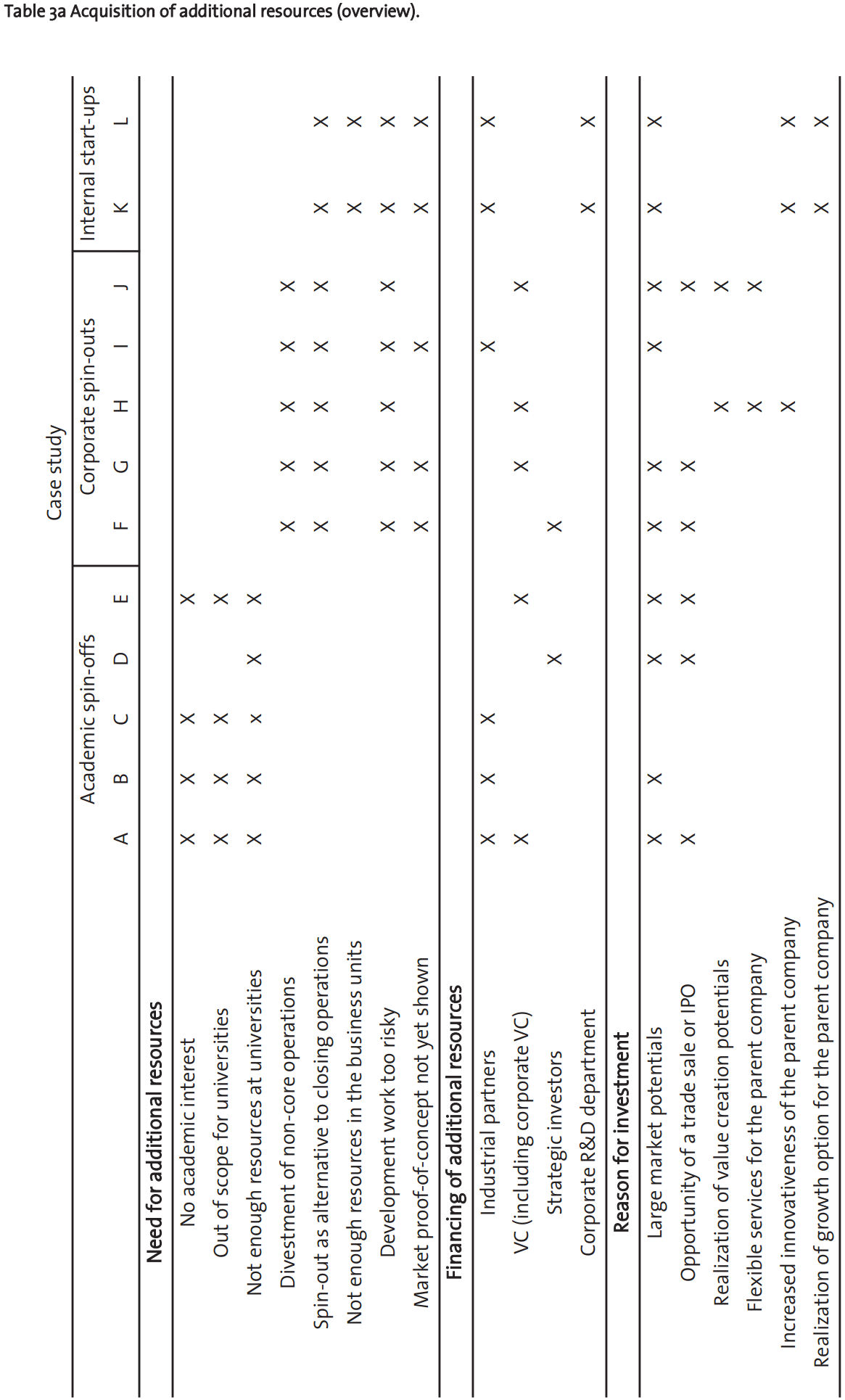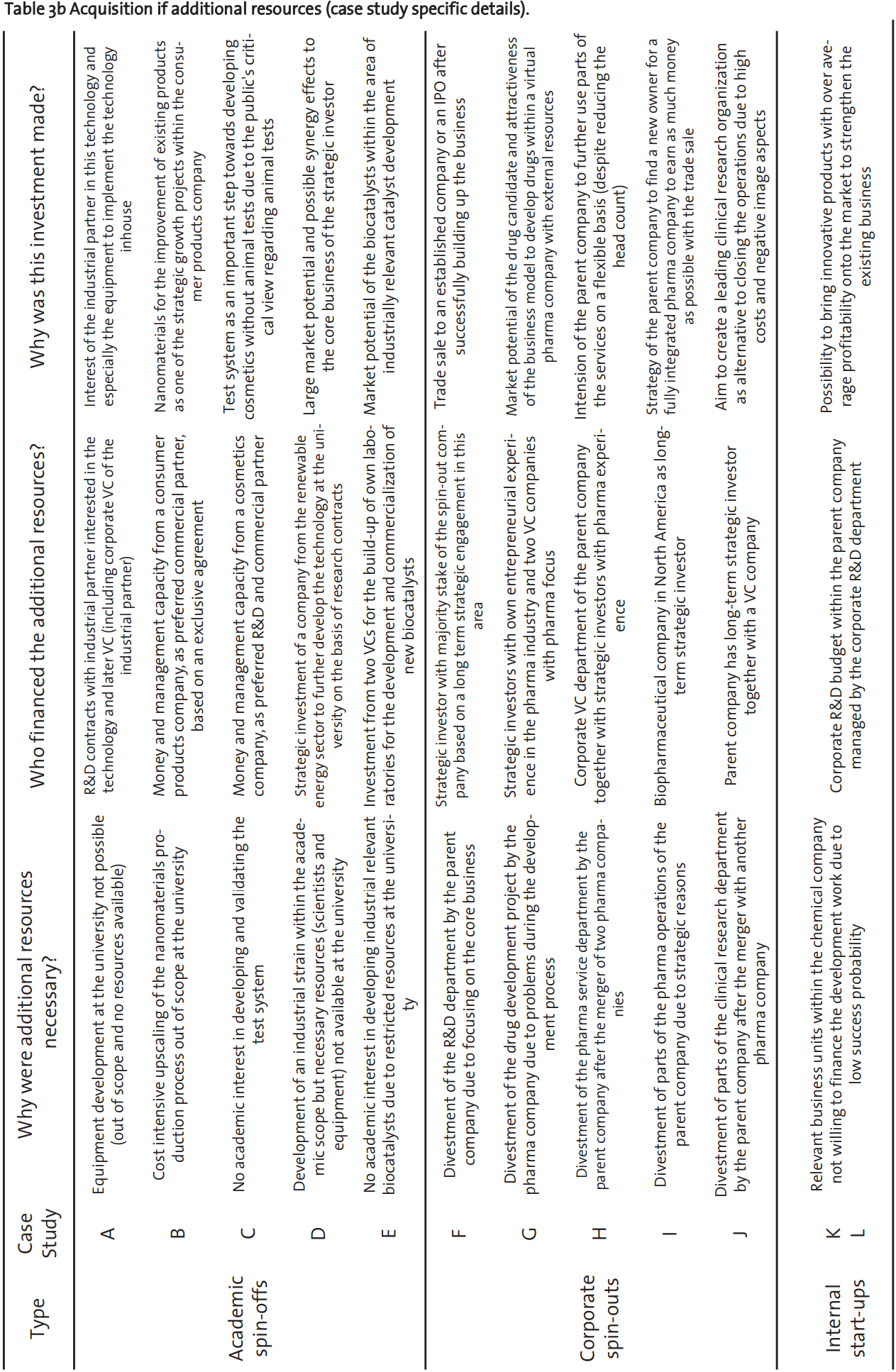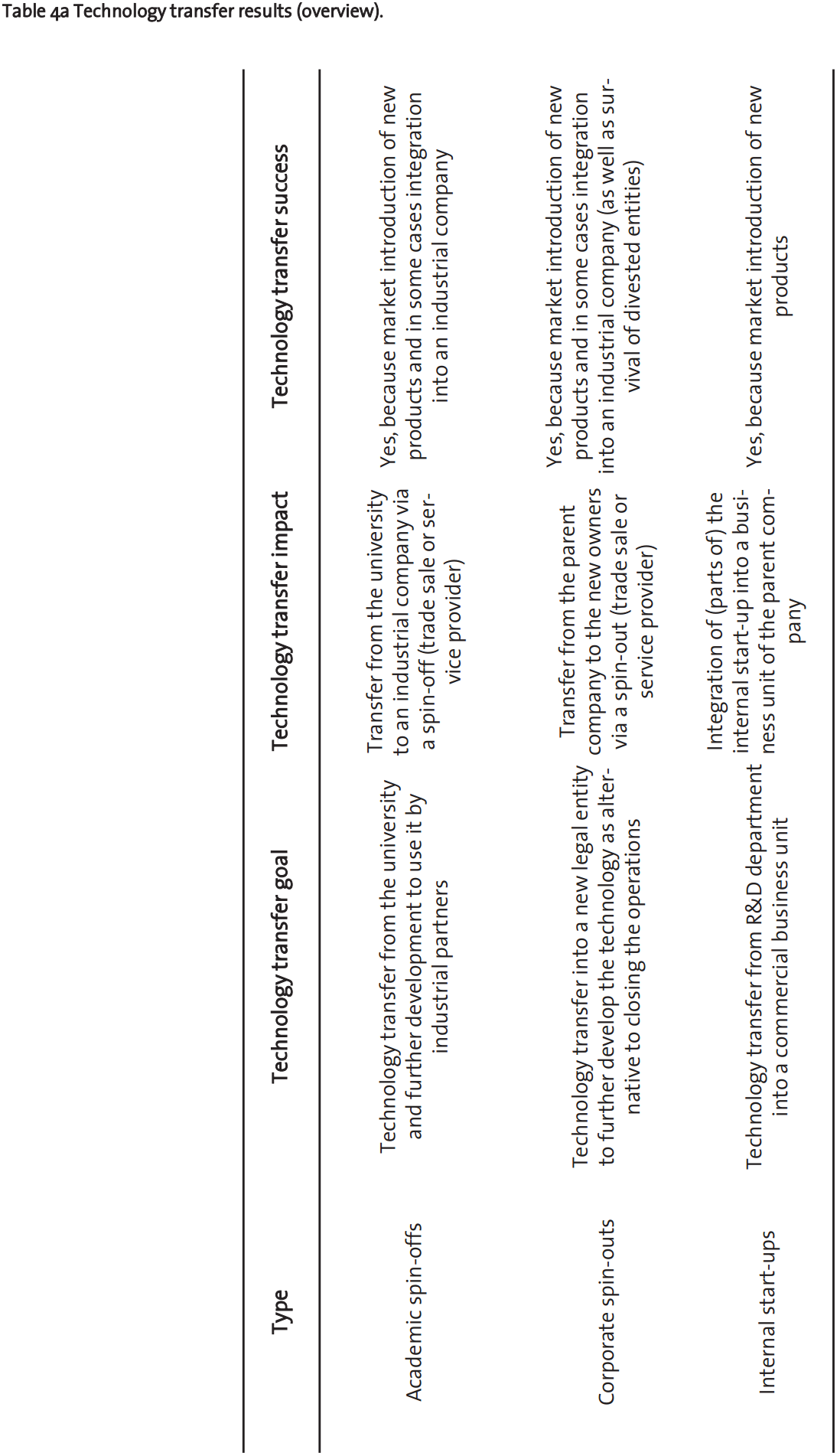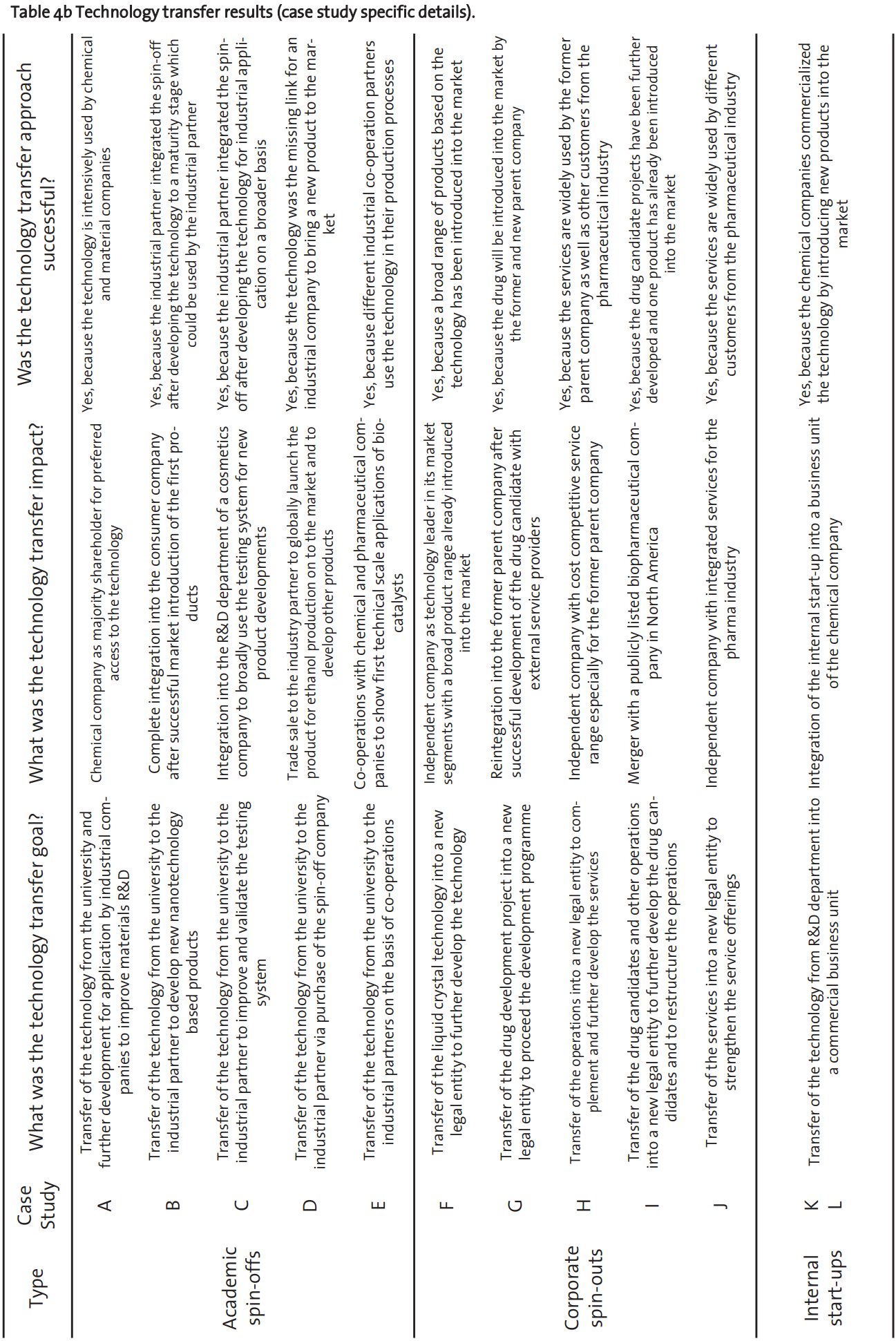Technology transfer by new ventures within the chemical and pharmaceutical industry
Abstract
The role of new ventures for technology transfer from universities and research institutions to companies and between companies focused on the chemical and pharmaceutical industry are discussed in this article. Different aspects of this technology transfer approach like the maturity of the technology, the acquisition of additional resources and the technology transfer results have been analysed based on case studies from the chemical and pharmaceutical industry in Germany and Switzerland. Especially established industries like the chemical and pharmaceutical industry rely on effective and efficient technology transfer to maintain their global competitiveness. Academic spin-offs can help to transfer technologies to the industry if further research and development work is out of scope of the academic institutions. Corporate spin-outs are an alternative to closing operations should these no longer fit into the parent organization. For technology transfer, both spinoffs and spin-outs can be integrated into a new parent company or work as service provider. Internal start-ups were identified as a new approach for company internal technology transfer from research departments to business units focused on commercial operations to overcome innovation barriers within companies.
1 Introduction
The European Union has been confronted with a phenomenon called knowledge paradox (Pavitt 2000). The high quality of research at universities and research institutions has not been translated into commercial applications in a sufficient way. Licensing is the established way to transfer technology from universities and research institutions to the commercial sector. But licensing is only applicable when technologies can be protected by patents (Hearn 1981). If the technology is not mature enough to establish strong IP rights, the commercialization of the technology is difficult. Besides licensing, academic spin-offs from universities and research institutions can be used for technology transfer (Franklin et al. 2001). Despite the fact that normally licensing is short-term financially more attractive, the ownership of equity in spin-offs may increase the potential up-side gain and is an attractive option to universities and research institutions. Taking equity in a spin-out company can produce a greater average return in the long run compared to licensing business (Bray and Lee 2000).
This paper investigates the creation of new ventures like spin-offs and spin-outs as a method for technology transfer from universities and research institutions to companies and between companies. Additionally, the approach of internal start-ups for company internal technology transfer, which is not yet described in the scientific literature, was identified during our research. The paper specifically seeks to address the following research questions.
- RQ1? How was the maturity of the technologies increased within the new ventures?
- RQ2? How were additional resources acquired by the new ventures?
- RQ3? Which technology transfer results were achieved by the new ventures?
The chemical and pharmaceutical sectors as mature industries were selected as they rely on effective and efficient technology transfer to maintain their global competitiveness. They are globally one of the largest manufacturing industries with strong impact on other industries. The regional focus was on the two countries Germany and Switzerland with a globally very strong chemical and pharmaceutical industry. This regional focus was chosen to have the same general cultural background which makes the analysis of the organizational, managerial, financial and cultural similarities and dissimilarities more reliable.
Section 2 of this paper provides the theoretical background according to academic spin-offs and corporate spin-outs. The methodology is described in section 3, the results and discussions are shown in section 4 and the implications and conclusions in section 5.
2 Theoretical background
2.1 Academic spin-offs
Technology transfer through the creation of academic spin-offs is important especially in high tech areas (Shane 2002; Heirman and Clarysse 2004; Stam et al. 2009). There has been a substantial increase in the number of academic spin-offs created in Europe (Wright et al. 2004; Moray and Clarysse 2005; Clarysse et al. 2007). This is based on a change in government policies that encourage universities and research institutions to commercialize their research results. Besides teaching and research, it is a mission for universities and research institutions to support economic and social development by commercializing the output of basic research through technology transfer (Etzkowitz et al. 2000; Etzkowitz 2003).
In the United States, the Bayh-Dole Act has granted the institutions, in which research is conducted using governmental funds, ownership of their research outcome in order to support their commercial application (European Commission 2003; Grimaldi et al. 2011). In consequence, the enactment of the Bayh-Dole Act in 1980, accompanied by other measures (Popp Berman 2008), had been substantially enhanced the commercialization of technologies developed at universities and research institutions. In contrast in Europe the legislative counterparts were lagging behind for about 20 years (Grimpe and Fier 2010) and the policy approaches are very heterogeneous (Mustar et al. 2008; Wright et al. 2008). Following the United States model, several European countries adopted comparable policies aimed at encouraging a more active role for academic institutions in technology transfer (Grimaldi et al. 2011) on national level, while other countries have acted in exactly the opposite way. In line with Bayh-Dole, Germany made an equivalent step through the abolishment of the so-called professors’ privilege in 2002, which had granted the scientists the right to claim ownership of the research outcome of their scientific work, even if the underlying research was funded by public money designated to the university. In the same year, however, Italy, has newly introduced the professors’ privilege. In contrast to these regulations on national level, in other European countries such as the United Kingdom each university has defined its own rules in respect of the ownership of the research results (Czarnitzki et al. 2009).
Founding a start-up out of a university or research institution is a special challenge for entrepreneurs. Normally academic researchers do not have the knowledge, expertise or experience to commercialize their research results (Litan and Mitchell 2007). Therefore, many universities and research institutions have implemented technology transfer offices (TTOs), entrepreneurship centers, and incubators (Goldfarb and Henrekson 2003; Bercovitz and Feldmann 2006; Rasmussen et al. 2006). These TTOs recognise start-ups as an interesting method of technology transfer and thus help scientists in their entrepreneurial efforts (Markman et al. 2005; Meyer 2006). It is important that universities and research institutions have clear strategies towards spin-off activities (Lockett et al. 2003). This includes the build-up of expertise and networks as well as the allocation of sufficient resources to realize the strategy in a professional way.
2.2 Corporate spin-outs
Whereas the term R&D spin-off stands for a new company based on the findings of members of a research group from academia, the common definition of spin-out is when a part (department, business unit division or even a project team) of a company or organization becomes an independent business (De Cleyn and Braet 2009; Mustar et al. 2006). But the two terms are not always used unambiguously, as sometimes the term corporate spin-off is used for a small company which has been split-off from a larger, parent organization. Following a merger or simply complementing a strategic realignment on core areas, spin-outs provide an option to leverage assets of low strategic importance, or underexploited assets in their parent companies. The spin-out company takes personnel, assets, IP, technology, and existing products from the parent organization. In many cases the management team of the new company originates from the same parent organization. A corporate spin-out may initially face fewer difficulties than an academic spin-off, because companies, as parent organisations, could assist a start-up company better than universities and research institutions (Jagersma and van Gorp 2003). The parent company provides the necessary assets and IP and an external investor finances the liquidity of the new start-up.
In the case of redundant capacities or non-core activities (e.g. after a merger of two companies), a spin-out can be used to reduce capacities and costs as an alternative to closing or selling the unit (Parhankangas and Arenius 2003; Bergh and Lim 2008). The reduction of capital requirements and risk, if R&D projects are not in the strategic focus of a company, can be another reason (Chemmanur and Yan 2004). As many areas of the R&D process chain can be outsourced and covered by external service providers, they will play a more important role in industrial R&D. Service oriented spin-offs and spin-outs contribute towards this, as these provide highly specialized services. Therefore, spinouts can also be used as a method to make R&D more flexible for increased effectiveness and efficiency (Krishnaswami and Subramaniam 1999).
3 Methodology
3.1 Research approach and quality
The research method used in this study was the case study approach, due to its many benefits. It represents a combination of learning just by watching (Helper 2000) with the main advantage being that the object of study is studied in real life context (Yin 1981). Flyvberg (2006) states that “the case study produces the type of context dependent knowledge that research on learning shows to be necessary to allow people to develop from rulebased beginners to virtuoso-experts”.
In contrast to the single case study approach, which aims at falsifying theoretical insights or to provide new insights in unexplored phenomena (Yin 2003; Yin 2006), many authors consider results from multiple case studies as more convincing, trustworthy, and robust (Eisenhardt 1989; Yin 2006). Therefore, the multiple case study approach was applied in this research, which compares cases and highlights resulting insights through similarities and dissimilarities between them. The cases were selected on an objective of maximum variation, thus enabling us to obtain information on the significance of various circumstances for the identified case studies (Flyvbjerg 2006).
In order to gain a better understanding of actual events and to avoid the influence of personal views and theoretical perspectives on the data collection, interviews based on a narrative approach (Polkinghorne 1988; Czarniawska 1998; Pentland 1999) were conducted, whereby the interviewees described their role with little interruption from the interviewer. To develop the case studies, semistructured interviews were used as well as the inclusion of various sources of qualitative and quantitative data, such as document and literature analysis and observations (Yin 2006). As suggested by Eisenhart (1989), data triangulation was used to help achieve a more holistic view of the case studies. With the different rounds of interviews and the combination of the various sources of information collected over a long period of time, an in-depth description of the different technology transfer approaches was obtained.
Quality assurance is important when conducting explorative research applying a multiple case study approach and analysing qualitative data research (Bortz and Döring 2005; Yin 2006; Corbin and Strauss 2008; Lamnek 2008). As Yin (2006) stated, reliability of qualitative research can only be achieved by a structured way of proceeding and by exactly documenting the research process and its results. Since there can be no validity without reliability, a demonstration of validity is sufficient to establish reliability, so that reliability is a consequence of the validity in a study (Patton 2002).
3.2 Data collection and analysis
Between 2004 and 2006, literature research on academic spin-offs, corporate spin-outs and their application for technology transfer in both academic and practitioner oriented journals as well as the internet was carried out. With the information collected, a database was obtained with interesting examples from two industries (chemicals and pharmaceuticals) and two technologies (biotechnology and nanotechnology) in Germany and Switzerland. From this database, 15 academic spinoffs, 12 corporate spin-outs, 16 universities and research institutions as well as 6 TTOs, 25 companies and 23 venture capitalists (VCs) including corporate VCs were selected based on their fit to the research scope and their interest in and availability for an interview. Narrative interviews were conducted with them between 2006 and 2008. Oneon-one interviews of approximately one hour were conducted in an unstructured, open-end way without any formal questionnaire. Prior to the interview, the interviewer collected in-depth information on the company or institution through various public sources (e.g. databases, website, press releases) to enable an efficient conduct of the interviews.
The selection of case studies from the interviews for the research was based on an objective of maximum variation to cover the whole range of cases, the potential to obtain appropriate answers, and the willingness to further participate in this study. Table 1 shows details of the 12 selected case studies from Germany and Switzerland: 5 case studies each for academic spin-offs and corporate spinouts and 2 for internal start-ups (see appendix). The same interviewer conducted again one-on-one interviews with the 12 selected case studies between 2008 and 2009. This time semi-structured interviews were used in order to develop these 12 case studies, whereby a reference set of questions was developed as a guideline for the interview, which allowed room for spontaneous answers. The questions were structured around different topical groups, like basic data regarding the case studies (parent institution and technology owner, involved parties), background for creating a new venture (reasons and strategy, relevance of technology transfer aspects), realization of the a new venture (conceptual design, engagement of investors, spinoff/spin-out process) and the results of these activities (development of the new venture, achievement of technology transfer goals).
The results of these semi-structured interviews as well as the narrative interviews were analysed and compared regarding the research questions. Additional secondary data was collected from the interviewees and through internet research for all the case studies. To identify relevant scientific literature and to update the case studies, a final literature research was conducted in the first half of 2011.
4 Results and discussions
4.1 Maturity of the technology
Within all analysed academic spin-offs the maturity of the technology was not sufficient to directly commercialize the technology. Table 2a shows the case specific mix of the identified aspects causing the need for further development of the technology and Table 2b case study specific details (see appendix).
All case studies had proof-of-concept only at laboratory scale with missing upscaling know-how to realize technical scale. Other aspects are no cost effective production processes, so that the new products cannot be produced on a cost competitive level, low relevance for industrial applications or insufficient performance. If there is no customer feedback, due to a missing prototype or access to customers, the customer acceptance of the new products is unclear. Further R&D is also necessary, if the new products have no competitive advantage in the eyes of the customers. No validation for commercial use and no fulfilled regulatory hurdles are also reasons for additional R&D activities. Case study B had a production technology for new nanomaterials only in laboratory scale without any expertise and experience for upscaling into the technical scale. The further R&D work focused on the upscaling of the laboratory process into a technical feasible process and development of formulations for a customer from the consumer industry. The result was a cost effective production process for a broad range of nanomaterials and formulations which could be directly used by the customer.
The identified kinds of further R&D work showed typical aspects. Equipment development means developing hardware and software for the cost efficient implementation of a new technology in the industry. Of importance is also upscaling of production processes through process development and the development of a cost effective production process. The improvement of performance enables the implementation in the industry. Scientific understanding of key aspects enables to improve the performance and to fulfil regulatory requirements. Other aspects are the development of industrial applications (e.g. implementation of products and technologies in the industry), the development of special grades or formulations for technical applications and the development of marketable products or service offerings. All these aspects were relevant for case study D. The development of industrial relevant strains for the proof of the genetic tools to modify microorganisms for the production of biofuels and bio-based chemicals was the critical step to get an industrial relevant strain with sufficient performance (yield, robustness) to produce ethanol in world scale production plants. Also within case study E, the improvement of biocatalysts in selected technical processes together with industrial partners was necessary to develop biocatalytic systems used in industrial applications with high performance and lower production costs compared to established chemical systems.
Typical results of the further R&D activities could be identified. An example for the importance of equipment for industrial applications and of providing of fee-for-service work is case study A. The high throughput experimentation technology had at the university only proof-of-concept in laboratory scale and high operational costs in industrial applications due to low automation of the process. The development of high throughput experimentation equipment enabled the spin-off to provide fee-for-service work for industrial customers and to sell the equipment to these customers. Other results were cost effective production processes for larger quantities, formulations for customer specific solutions and validated systems with certification.
The aspects describing the need for further R&D work in the case of corporate spin-outs and internal start-ups were rather similar to academic spinoffs, i.e. there is no clear difference between the three groups. Also, the kinds and the results of further R&D work were very similar in the three groups of case studies. Case study H shows that the corporate spin-out enabled the further development of selected technologies and correlated services based on scientific expertise. The result was a worldwide well-known provider of special pharma development services with strong teams consisting of scientists and marketing and sales experts. The described aspects were also relevant for case study K. The new nanomaterials from the laboratory were not really relevant for the industry as the particle size and the application properties were not suitable for industrial processes. Further R&D work of the internal start-up together with the business units of the parent company solved these problems. Another result was the cost effective production process for a broad range of nanomaterials and formulations which could be directly used by the consumer company in their products.
4.2 Acquisition of additional resources
Clear differences can be seen in the three groups, academic spin-offs, corporate spin-outs and internal start-ups, with regard to the acquisition of additional resources to realize the additional R&D work. Table 3a shows the identified aspects and table 3b the case study specific details (see Appendix).
Academic spin-offs need additional resources because there is no academic interest in further R&D, the topics are out of scope of universities or there are not enough resources at universities. Financing of additional resources is made by industrial partners, VC and corporate VC as well as strategic investors. Case study E showed the need for additional resources at universities in areas which are out of scope and not interesting from an academic point of view. The cost intensive further R&D work to develop industrial relevant biocatalysts could not be financed by the universities as technology owner and was financed by VC. Case study D is an example for a technology development within the academic scope of the university but where the necessary resources were not available at the university and a strategic investor financed these resources. Case studies A, B and C were examples of an investment of industrial partners who worked along with their investment also operationally close with the academic spin-off. The main reasons for investment are large market potentials and the opportunity of a trade sale or initial public offering (IPO) attracting strategic and VC investors.
For more and more non-core R&D projects in industrial companies there are not enough company internal resources (capital, management capacity) available resulting in the divestment of these projects. The need for additional resources for corporate spin-outs is caused by this divestment process from the parent company. In the case of corporate spin-out J, the parent organization spun-out parts of the clinical research department as an alternative to closing down operations. Another possible reason to realize a spin-out is the isolation of high risk projects, in order to protect the parent company from these risks, like in the case of case studyG. The divestment of a drug development project by the parent company was the result of company internal problems during the development process which increased the further development risk significantly. These spin-outs enable companies to concentrate on their core activities, without having to abandon new products coming from these projects. As in the case of academic spin-offs, the additional resources are financed by industrial partners, VC including corporate VC and strategic investors. Reasons for the investment are, besides the opportunity of a trade sale or IPO, the realization of value creation potentials and to provide flexible services for the parent company. Case study H was the divestment of a pharma service department after the merger of two pharma companies. The spin-out was realized by the corporate VC department of the parent company together with strategic investors with pharma experience. A major intension of the parent company was, despite the reduction in headcount, to further use parts of the services which were no longer available inhouse on a flexible basis. Case study J was the divestment of parts of the clinical research department of a pharma company after the merger with another pharma company. Aim was the creation of a leading clinical research organization to further use these services.
The situation of internal start-ups is rather different compared to academic spin-offs and corporate spin-outs. The need for additional resources is due to the fact that the R&D work is too risky and the market proof-of-concept is not yet shown. As there are not enough resources in the business unit, the financing gap is closed by corporate R&D budgets. Within the case studies K and L, the relevant business units within a chemical company were not willing to finance the R&D work due to low success probability. The additional investment by corporate R&D budgets was made because there was the possibility to bring innovative products with over average profitability onto the market to strengthen the existing business. Aim from a corporate point of view was increased innovativeness and the realization of growth option which could not be realized with only the resources of the business unit.
4.3 Technology transfer results
The analysis of the technology transfer results showed some similarities and dissimilarities between the three groups. Table 4a shows the analysis regarding technology transfer goal, technology transfer impact and technology transfer success and Table 4b some case study specific details (see Appendix).
In the case of academic spin-offs, the goal is the technology transfer from universities to industrial partners. In all analysed cases studies, the technology transfer was successful: there were some market introductions of new products and, in some cases, the integration of the spin-off into an industrial company. For example, in case study D, there was a joint development of a new product and the later acquisition of the academic spin-off by the industrial partner. This enabled the global market launch of a new product for ethanol by combining the production and marketing/sales capabilities of the buying company and the technologies of the acquired spin-off. This is an example of the transfer of a technology from a university to a company via the purchase of the spin-off company. Case study A shows that the technology transfer is not only done through the sale of the spin-off but also by acting as a service provider for industrial customers.
Corporate spin-outs realize technology transfer from the parent company as a new legal entity to further develop the technology as an alternative to closing the operations. As in the case of academic spin-offs, the technology transfer can be realized by the trade sale to a new owner or by acting as a service provider. The case studies showed in some cases the market introduction of new products and in other cases the integration into a new company. For example, case studies H and J executed the transfer of the operations into a new legal entity with the aim to further develop and commercialize the services offerings. The result was independent companies with cost competitive services which were widely used by the former parent companies as well as other customers from the pharmaceutical industry. Internal start-ups, like case studies K and L, show the technology transfer from R&D departments into a commercial business unit. Result was in both cases the integration of (parts of) the internal startup into a business unit of the parent company in combination with the introduction of new products into the market.
5 Implications and conclusions
The analysis of the case studies confirmed that the creation of new ventures could be used for technology transfer from university, research institutions and companies as technology developers to companies as technology users (figure 1). In all case studies the maturity of the technology was not sufficient to directly commercialize the technology. Necessary was the further development of the technology to a stage interesting for established companies which are looking to offer concrete products or services. The technical proof-of-concept has normally to be done before investments in production, marketing and sales are made. The need for further R&D work is a central element of using new ventures for technology transfer combined with the fact that the parent organization (universities, research institutions and companies) is not able or willing to finance this additional R&D work.
Academic spin-offs can especially help to transfer technologies to the industry if they are out of scope of the academic institutions or there is no academic interest in the work. Corporate spin-outs can be used for technology transfer as a good alternative to closing R&D operations if they no longer fit into the parent organization and the technology is not mature enough to sell it directly. Both spinoffs and spin-outs have to acquire additional resources from external partners like financial investors or industrial co-operation partners to increase the maturity of the technology. The technology transfer back to industrial companies can work in two ways: the new ventures can work as service provider as an independent company or be sold and integrated into a new company.
The principle of company internal start-ups, which is using many elements of academic spinoffs and corporate spin-outs, can help to improve technology transfer from research labs of R&D departments to commercial business units within the same company. The internal start-up will be integrated into an operational business unit if the technological and market proof-of-concept is shown. Corporate spin-outs and internal start-ups can overcome innovation barriers like bureaucratic thinking, fear of cannibalism or the well-known ‘not invented here’ syndrome which are normally found within companies.
The new ventures enable the opportunity to combine scientific expertise with business expertise of external managers or entrepreneurs. They can more easily pick up external impulses and serve as a mechanism to explore revolutionary ideas in a setting apart from mainstream business. For example, competencies from other companies or top-class scientists from universities and research institutions can be engaged to form excellent teams.
References
Bercovitz, J. and Feldmann, M. (2006): Entrepreneurial universities and technology transfer: a conceptual framework for understanding knowledge-based economic development, Journal of Technology Transfer, 31 (1), pp. 175-188.
Bergh, D.D. and Lim, E.N.K. (2008): Learning how to restructure: absorptive capacity and improvisional views of restructuring actions and performance, Strategic Management Journal, 29, pp. 93-616.
Bortz, J. and Döring, N. (2005): Forschungsmethoden und Evaluation, 3rd ed., Springer, Heidelberg.
Bray, M. J. and Lee, J.N. (2000): University Revenues from Technology Transfer: Licensing Fees vs Equity Positions, Journal of Business Venturing, 15 (5/6), pp. 385-392.
Chemmanur, T.J. and Yan, A. (2004): A theory of corporate spin-outs, Journal of Financial Economics, 72, pp. 259-290.
Clarysse, B., Wright, M., Lockett, A., Mustar, P. and Knockaert, M. (2007): Academic spin-offs, formal technology transfer and capital raising, Industrial and Corporate Change, 16 (4), pp. 609-640.
Corbin, J. and Strauss, A.C. (2008): Basics of qualitative research, 3rd ed., Sage, Thousand Oaks.
Czarniawska, B. (1998): A Narrative Approach to Organization Studies, Sage, London.
Czarnitzki, D., Glänzel, W. and Hussinger, K. (2009): Heterogeneity of patenting activity and its implications for scientific research, Research Policy, 38 (1), pp. 26-34.
De Cleyn, S.H. and Braet, J. (2009): Research valorisation through spin-off ventures: Integration of existing concepts and typologies, World Review on Entrepreneurship, Management & Sustainable Development, 5 (4), pp. 325-352.
Eisenhardt, K.M. (1989): Building theories from case study research, The Academy of Management Review, 14 (4), pp. 532-550.
Etzkowitz, H. (2003): Research groups as ‘quasifirms’: The invention of the entrepreneurial university, Research Policy, 32, pp. 109-121.
Etzkowitz, H., Webster, A., Gebhardt, C. and Terra, B.R.C. (2000): The future of the university and the university of the future: Evolution of the ivory tower to entrepreneurial paradigm, Research Policy, 29, pp. 313-330.
European Commission (2003): The Role of the Universities in the Europe of Knowledge, Communication, (COM(2003) 58).
Flyvberg, B. (2006): Five misunderstandings about case-study research, Qualitative Inquiry, 12 (2), pp. 219-245.
Franklin, S., Wright, M. and Lockett, A. (2001): Academic and surrogate entrepreneurs in university spin-out companies, Journal of Technology Transfer, 26 (1/2), pp. 127-141.
Goldfarb, B. and Henrekson, M. (2003): Bottom-up versus top-down policies towards the commercialization of university intellectual property. Research Policy, 32 (4), 639-58.
Grimaldi, R., Kenney, M., Siegel, D.S. and Wright, M. (2011): 30 years after Bayh–Dole: Reassessing academic entrepreneurship, Research Policy, 40 (8), pp. 1045-1057.
Grimpe, C. and Fier, H. (2010): Informal university technology transfer: a comparison between the United States and Germany, The Journal of Technology Transfer, 35 (6), pp. 637-650.
Hearn, P. (1981): The Business of Industrial Licensing, Farnham: Gower Press.
Heirman, A. and Clarysse, B. (2004): How and why do research-based start-ups differ at founding? A resource-based configurational perspective, Journal of Technology Transfer, 29 (3-4), pp. 247-68.
Helper, S. (2000): Economists and field research: You can observe a lot just by watching, American Economic Review, 90, pp. 228-232.
Jagersma, P.K. and van Grop, D.M. (2003): Spin-out management: Theory and practice, Business Horizons, 46 (2), pp. 15-24.
Krishnaswami, S. and Subramaniam, V. (1999): Information asymmetry, valuation, and the corporate spin-out decision, Journal of Financial Economics, 53, pp. 73-112.
Lamnek, S. (2008): Qualitative Sozialforschung, 4th ed., Beltz, Weinheim.
Litan, R.E., Mitchell, L. and Reedy, E.J. (2007): The university as innovator: Bumps in the road, Issues in Science and Technology, (Summer), 23 (4), pp. 57-66.
Lockett, A., Wright, M. and Franklin, S. (2003): Technology Transfer and Universities’ Spin-Out Strategie, Small Business Economics, 20, pp. 185-200.
Markman, G., Phan, P., Balkin, D. and Giannodis, P. (2005): Entrepreneurship and university-based technology transfer, Journal of Business Venturing, 20 (2), pp. 241-63.
Meyer, M. (2006): Academic inventiveness and entrepreneurship: On the importance of start-up companies in commercializing academic patents, Journal of Technology Transfer, 31 (4), pp. 501-10.
Moray, N. and Clarysse, B. (2005): Institutional change and resource endowments to science-based entrepreneurial firms, Research Policy, 34 (7), pp. 1010-1027.
Mustar, P., Renault, M., Colombo, M.G., Piva, E., Fontes, M., Lockett, A., Wright, M., Clarysse, B. and Moray, N. (2006): Conceptualising the heterogeneity of research-based spin-offs: A multidimensional taxonomy, Research Policy, 35 (2), pp. 289-308.
Mustar, P., Wright, M. and Clarysse, B. (2008): University spin-off firms: Lessons from ten years of experience in Europe, Science and Public Policy, 35 (2), pp. 67-80.
Pavitt, K. (2000): Why European Union funding of academic research should be increased: A radical proposal, Science and Public Policy, 27 (6), pp. 455-460.
Parhankangas, A. and Arenius, P. (2003): From a corporate venture to an independent company: a base for a taxonomy for corporate spin-out firms, Research Policy, 32, pp. 463-481.
Patton, M.Q. (2002): Qualitative evaluation and research methods, 3rd ed., Sage, Thousand Oaks.
Pentland, B.T. (1999): Building process theory with narrative: from description to explanation, Academy of Management Review, 24 (4), pp. 711-724.
Polkinghorne, D.E. (1988): Narrative Knowing and The Human Sciences, State University of New York Press, Albany.
Popp Berman, E. (2008): Why Did Universities Start Patenting?: Institution-building and the Road to the Bayh-Dole Act, Social Studies of Science, 38 (6), pp. 835-871.
Rasmussen, E., Moen, O. and Gulbrandsen, M. (2006): Initiatives to promote commercialization of university knowledge, Technovation, 26 (4), pp. 518-533.
Shane, S. (2002): Selling university technology: Patterns from MIT, Management Science, 48 (1), pp. 122-38.
Stam, E., Suddle, K., Hessels, J. and Stel, A. (2009): High-growth entrepreneurs, public policies and economic growth, International Studies in Entrepreneurship, 22 (1), pp. 91-110.
Wright, M., Vohora, A. and Lockett, A. (2004): The Formation of High Tech University Spinout Companies: The role of Joint Ventures and Venture Capital Investors, Journal of Technology Transfer, 29, pp. 287-310.
Wright, M., Clarysse, B., Lockett, A. and Knockaert, M. (2008): Mid-range universities’ linkages with industry: Knowledge types and the role of intermediaries, Research Policy, 37 (8), pp. 1205-1223.
Yin, R.K. (1981): The case study crisis: some answers, Administrative Science Quarterly, 26 (1), pp. 58-65.
Yin, R.K. (2003): Case study research – design and methods. 3rd ed., Sage, Thousand Oaks.
Yin, R.K. (2006): Mixed methods research: Are the methods genuinely integrated or merely parallel?, Research in the Schools, 13 (1), pp. 41-47.
Appendix
